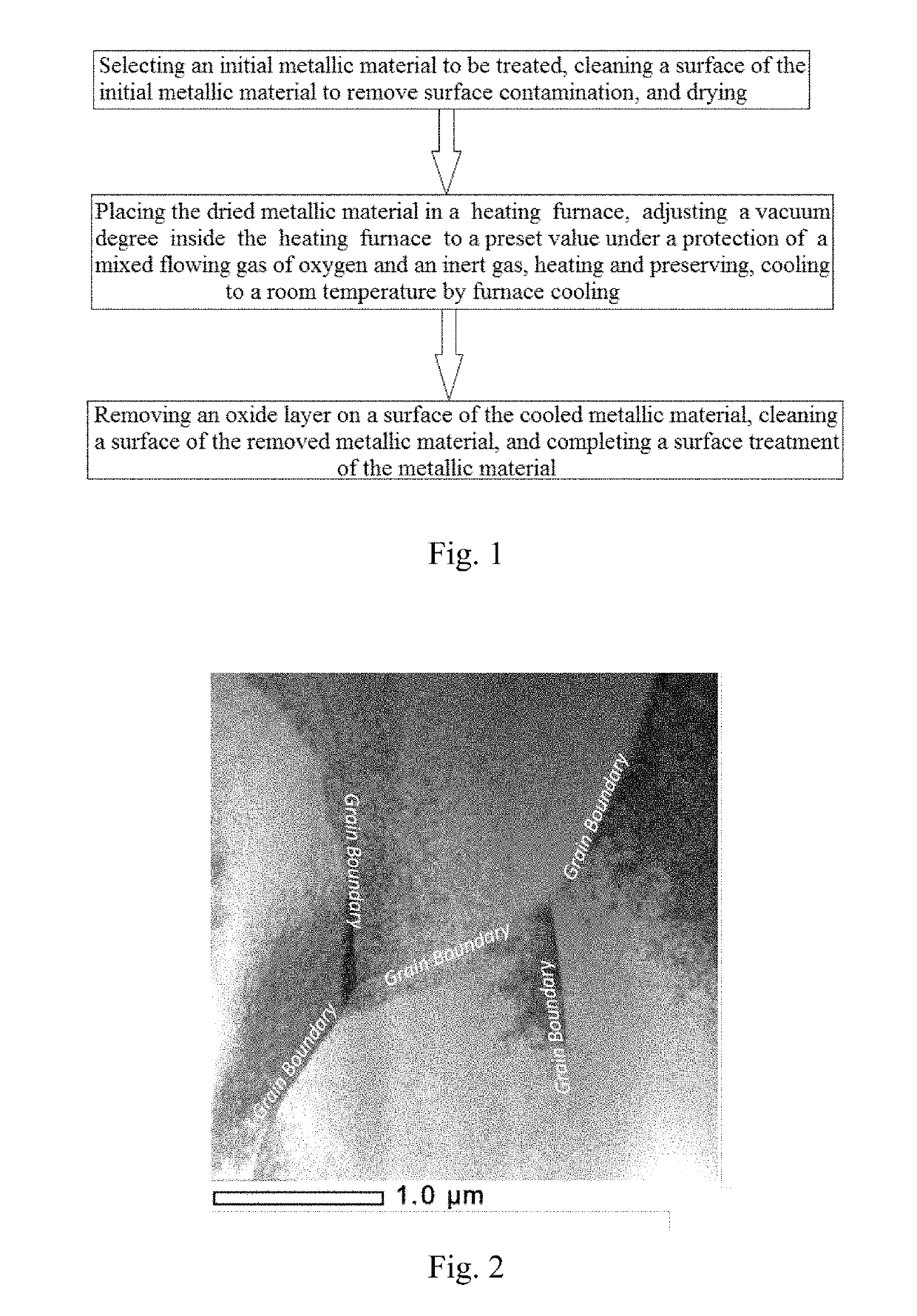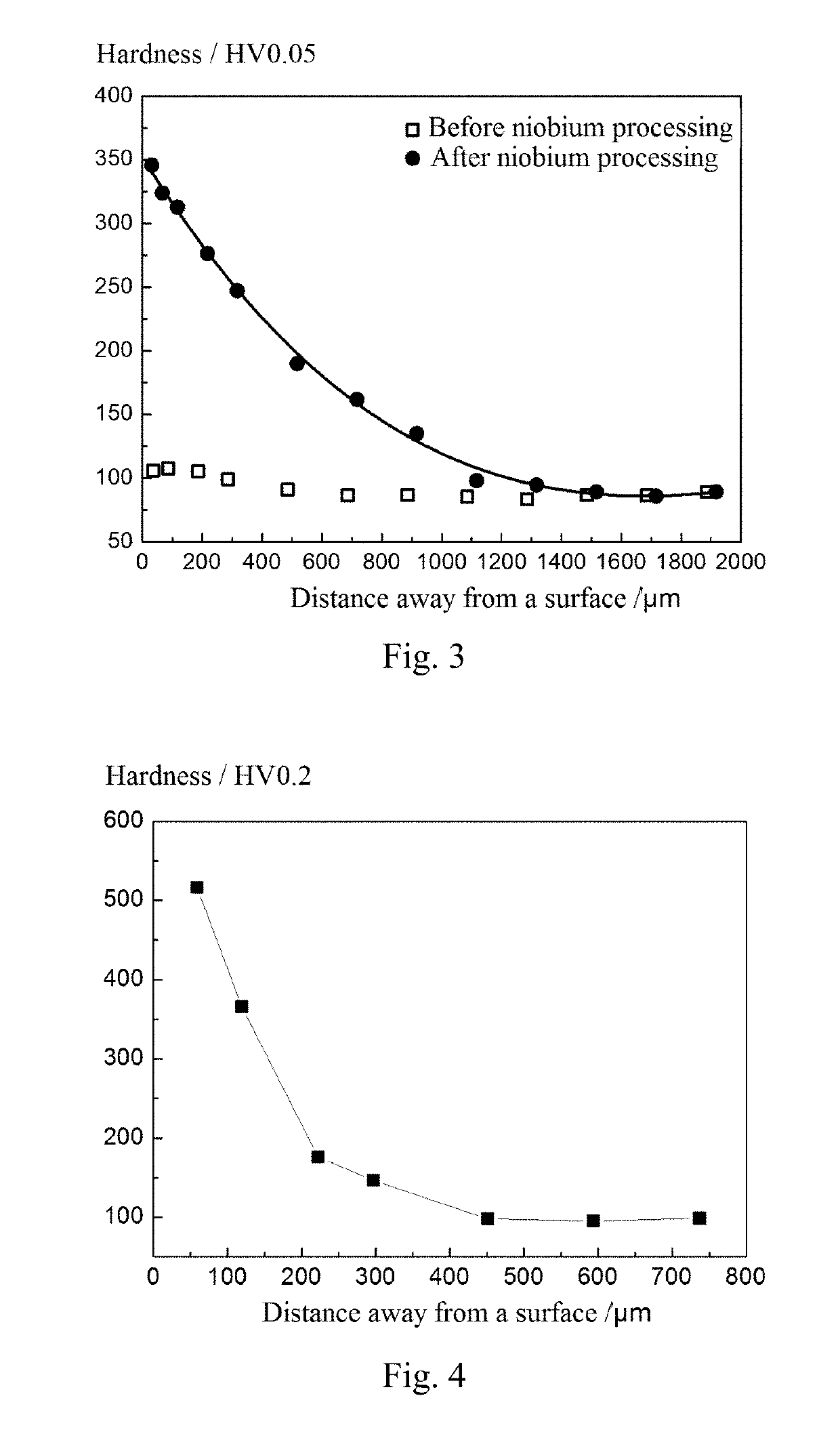Surface treatment method of metallic materials
a surface treatment method and metal material technology, applied in heat treatment apparatus, furnaces, manufacturing tools, etc., can solve the problems of large amount of surface treatment methods of metallic materials, internal oxidation and surface decarburization are inevitable problems, and the structure of metals usually works, etc., to achieve simple and convenient operation, prevent the movement of hinges, and facilitate the effect of operation
- Summary
- Abstract
- Description
- Claims
- Application Information
AI Technical Summary
Benefits of technology
Problems solved by technology
Method used
Image
Examples
first embodiment
[0031]Take a metallic pure niobium rod with a diameter of 4 mm and a length of 8 mm, cut a surface of the niobium rod with a grinding machine, and clean the cut niobium rod with acetone, place the cleaned niobium rod in a tube furnace, introduce a mixed gas of oxygen and argon gas with a flowing rate of 1000 sccm into the tube furnace, wherein a volume ratio of oxygen in the mixed gas is 0.2%, remain a vacuum degree inside the tube furnace to be 250 Pa through controlling a pumping speed of a mechanical pump, heating to 1000° C. at a heating rate of 10° C. / min and preserving for 1 h, cooling to a room temperature via furnace cooling, removing an oxide layer on a surface of the cooled niobium rod by grinding with sandpaper, and finally obtain a treated sample.
[0032]Referring to FIG. 2, the obtained sample is characterized by transmission electron microscopy at a position 20 μm away from the topmost surface, and only defects such as dislocation loops which are introduced by the prepar...
second embodiment
[0034]Take a metallic pure vanadium sheet with a thickness of 1.2 mm, place the vanadium sheet in a tube furnace, introduce a mixed gas of oxygen and argon gas under normal pressure into the tube furnace, wherein a volume ratio of oxygen in the mixed gas is 5%, heating to 650° C. at a heating rate of 10° C. / min and preserving for 10 h, cooling to room temperature by furnace cooling, and finally obtaining a sample.
[0035]Referring to FIG. 4, a surface of the obtained sample is continuously ground and polished to remove the oxide layer obtained by oxygen permeation from the upper surface of the vanadium sheet, and the cross-sectional hardness from the side surface to the core of the obtained sample is measured. It can be seen from FIG. 4 that significant hardening occurs in the range of 450 μm away from the side surface of the obtained sample. In addition, the hardness at the surface of the obtained sample is five times that of the core of the obtained sample, and gradually decreases f...
PUM
| Property | Measurement | Unit |
|---|---|---|
| preserving time | aaaaa | aaaaa |
| temperature | aaaaa | aaaaa |
| length | aaaaa | aaaaa |
Abstract
Description
Claims
Application Information
 Login to View More
Login to View More - R&D
- Intellectual Property
- Life Sciences
- Materials
- Tech Scout
- Unparalleled Data Quality
- Higher Quality Content
- 60% Fewer Hallucinations
Browse by: Latest US Patents, China's latest patents, Technical Efficacy Thesaurus, Application Domain, Technology Topic, Popular Technical Reports.
© 2025 PatSnap. All rights reserved.Legal|Privacy policy|Modern Slavery Act Transparency Statement|Sitemap|About US| Contact US: help@patsnap.com


